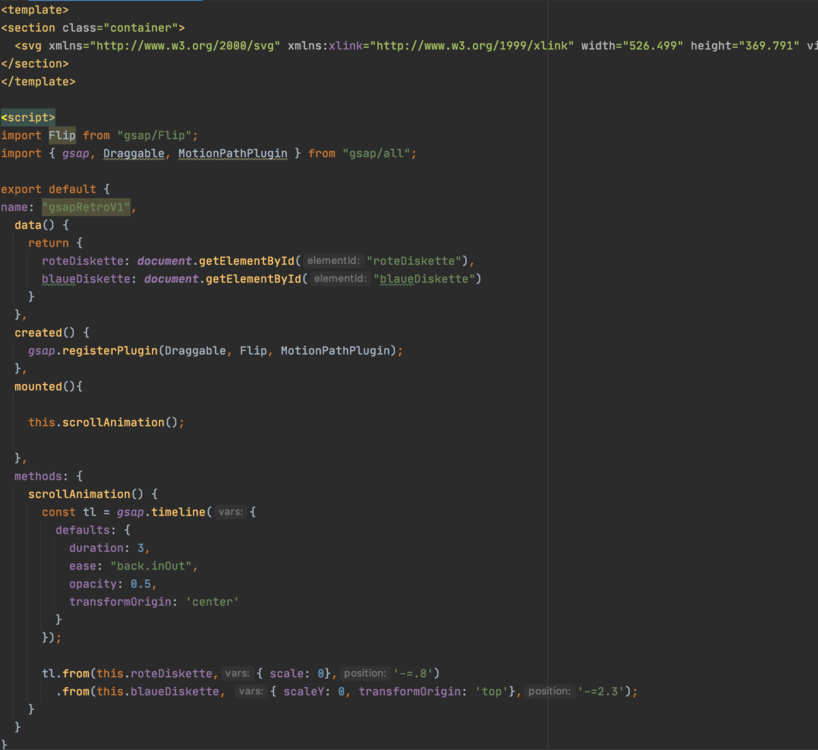Search the Community
Showing results for tags 'nuxt.js'.
-
For those looking to integrate ScrollSmoother with Nuxt, here's a solution that builds off some of the work by @Born05 in this thread. CodeSandbox: https://codesandbox.io/s/gsap-scrollsmoother-nuxt-pbhmeh?file=/layouts/default.vue All you have to do is include the GSAPScrollSmoother and put whatever content you want inside of this. <GSAPScrollSmoother :vars="{ smooth: 2, effects: true }"> <Nuxt /> </GSAPScrollSmoother> You'll be able to access the ScrollSmoother in any page/component using this.$scrollSmoother, and can use any of the methods available, for example. this.$scrollSmoother.paused(true); let velocity = this.$scrollSmoother.getVelocity(); There are also a couple of extra methods available. $scrollSmoother.parseEffects() Call this to get ScrollTrigger to parse and create effects that are declared with data attributes, (data-speed and data-lag). $scrollSmoother.killEffects() Call this to kill all the ScrollSmoother effects. You will typically need to call this when navigating to a new page. $scrollSmoother.refresh() Refresh the ScrollSmoother and all ScrollTriggers. You should call this when navigating to a new page if you don't call .parseEffects() There are really only 2 files you need to be concerned about. The GSAPScrollSmoother.vue component file, and the nuxt.config.js file. The nuxt.config.js has some pageTransition callbacks in there that you may need to adjust to your project. And if you plan on using this in your own project, be sure to change all the gsap-trial imports to gsap, otherwise you won't be able to deploy it. Example usage on a page... export default { mounted() { // if you don't have any effects, use this.$scrollSmoother.refresh() instead this.$scrollSmoother.parseEffects(); this.myAnimation = gsap.timeline({ scrollTrigger: { ... } }) }, beforeDestroy() { // kill any ScrollTriggers you created this.myAnimation.scrollTrigger.kill(); // kill the effects that were created this.$scrollSmoother.killEffects(); } }
-
I create a simple demo for this issue. https://stackblitz.com/edit/nuxt-starter-nsqfvz?file=pages/index.vue I use scrollTrigger in gsap.matchMedia(), 1. if I add the "pin" in home page (pages/index.vue), 2. and then go to other pages (pages/page2.vue) 3. resize with different breakpoint it will show this kind of error, Uncaught TypeError: trigger.revert is not a functio After I back to the home page, the scrollTrigger will not work anymore. And seems the scrollTrigger should be killed in "onUnmounted" ? Thank you~~~
- 6 replies
-
- nuxt3
- scrolltrigger
- (and 4 more)
-
I want to usenuxt-gsap-module on my nuxt app. I follow the docs in github : https://github.com/ivodolenc/nuxt-gsap-module but I can't acces to this.$gsap in may pages and components, it throws an error : Property '$gsap' does not exist on type 'XXX' my package.json file "devDependancies" : { "nuxt-gsap-module": "1.7.1" } index.vue boxRotation (): void { const gsap = this.$gsap gsap.to('.box', { rotation: 27, x: 100, duration: 1 }) } mounted () :void { this.boxRotation() } nuxt.config.js buildModules: [ '@nuxt/typescript-build', 'nuxt-gsap-module' ],
-
Intro: Theres probably not a simple anwser to this but I wanted to see if someone more gsap experienced than me knew of some cool trick that could help me before I go on to do some overly complicated way of solving my issue. Whatver the case, thanks to anyone who is willing to give my issue a shot one way or another. Context: So, I want to create a component builder that lets users drag and drop blocks in place. As part of this I am using GSAP Draggable to drag and drop an element. The riddle im stuck on at the moment is I want the element to snap into place when its dragged over an area that can receive it. The simple solution is to just use the hitTest() function to detect if eligeble element is hit and then get either the points off that element to use in the livesnap, or get the transforms to match that element or something like that. Problem is that in a more complex example, for my use case, I dont actually want to manually create a uniqe function for every possible snappable area since there might be a lot. The ultimate solution would be if I could somehow dynamically fetch whatever snappable element we have hit. But as far as I can tell, from the docs, the hitTest() doesnt actually return the hit element, it just returns a boolean which kinda forces me to do something uniqley for each individual element that can get hit. Question: Is there a straight forward way to dynamically get whatever element I hit with the hitTest()? Codepen: Ive provided a codepen that acts like a massive simplification of what I am trying to do just to narrow it down to exactly what I am asking and making easy to experiement with solutions. Hope that makes it simpler to understand.
-
nuxt.js Nuxt.js - Trigger a GSAP animation in a visible on screen.
Mahmut Demir posted a topic in GSAP
I have an index.ts with several components imported. see image: When the component is visible on my screen, i would like to trigger the animation in that specific component "gsapV1". the code looks like this: for now, everytime i refresh the page, the "gsapV1" is already animated. how to trigger the animation when visible on screen? thanks. -
Hello everyone! I was exploring smooth scrolling and scrolltrigger, found beautiful library called asScroll, tryied to add it to my Nuxt.js project. It kinda works, but scroll trigger is updating it's state only when scrolling is stopped, so the animation with scrub was not so smooth. Here is a minimal demo on codesandbox
- 3 replies
-
- scrolltrigger
- scrolltriggerproxy
-
(and 2 more)
Tagged with:
-
Banging my head a bit. I've got a few Scroll Trigger based animations on the home page of a site and it works flawlessly when in local development. It isn't until we've deployed to a production/staging environment does it break. Effectively what's happening is when we load the site on production/staging all animations run immediately. Not sure if its a component mounting issue (which would mean its not a GSAP issue) or if something is being compiled/computed differently in a live environment? Each section is setup as follows: 1. Define the animation/scroll trigger in the `mount` lifecycle hook 2. Use `$refs` to pass elements into the animation. <template> <div id="vid-container" class="h-screen w-screen bg-white"> <video @loadeddata="loaded" class="w-full fixed inset-0 duration-500 transition-opacity opacity-0" :class="{'opacity-100': videoLoaded}" src="https://player.vimeo.com/external/611257045.hd.mp4?s=785a9d52ed5d188f762436b1bb618493f784d3f5&profile_id=174" autoplay loop muted preload></video> <svg ref="mask" class="mask absolute w-full h-full" > <mask id="mask"> <rect width="100%" height="100%" fill="white"></rect> <text font-family="Bagnard, serif" font-weight="500" x="50%" y="49%" class="origin-center " text-anchor="middle" transform="scale(15)" > <tspan x="50%">Freelance</tspan> <tspan x="50%" dy="1em">Founders</tspan> <tspan style="font-size: .5rem" x="50%" dy="2em"> ↓ </tspan> </text> </mask> <rect id="bg" width="100%" height="100%" fill="#fff"></rect> </svg> </div> </template> <script> import { gsap } from "gsap"; import { ScrollTrigger } from "gsap/ScrollTrigger"; import { CSSRulePlugin } from "gsap/CSSRulePlugin"; if (process.client) { gsap.registerPlugin(ScrollTrigger, CSSRulePlugin); } export default { data() { return { videoLoaded: false, } }, mounted() { console.log('hero mounted') let width = window.innerWidth let speed = 350 //pixels per second let endX = width let duration = endX / speed let ease = "sine.inOut" let intro = ''; if (this.$refs.mask) { this.$nextTick(() => { intro = gsap.timeline({ onComplete: () => {}, scrollTrigger:{ trigger: this.$refs.mask, start: "bottom 100%", end: "bottom 50%", pin: true, scrub: true } }); intro.to(this.$refs.mask, { scale: 5, opacity: 0, duration: 5, ease: ease }, 'intro') } ) } }, methods: { loaded() { this.videoLoaded = true; } } } </script> Staging link example: https://freelance-founders-hgc9zjyrf-progresslabs.vercel.app/ FYI - Working on a minimal example to post here shortly.
-
Hi! I'm having problems with some Vue components in Nuxt and SplitText. I'll try to explain: I have a global mixin that detects all [data-animation] elements with the scroll and fire an specific animation. Some of these elements are components and ha. This works fine when I use opacity, X and Y, scale, etc... but when I use Split Text it doesn't. I got an hydrate error and the animation doesn't work. This is the code for the animation: if (elm.dataset.animation === 'lines-down-up-mask'){ var split = new SplitText(elm, { type: "lines", linesClass: 'lineParent' }); var split_parent = new SplitText(elm.getElementsByClassName('lineParent'), { type: "lines", charsClass: 'lineChild' }); gsap.set(split_parent.lines, { y: '110%' }); gsap.to(split_parent.lines, { scrollTrigger: { trigger: elm, scrub: false, start: 'top bottom', }, stagger: { each: 0.1, ease: 'power1.in', y: 0, }, onComplete: function(){ split.revert(); } }); } This is one of the components: <Partners data-bg-color="white" data-text-color="black" data-logo-color="black" data-scroll-section :title="partnerList.title" :partners="partners" /> And inside the component I have this: <template> <section class="partners"> <div class="headline headline--4 partners__title" data-animation="lines-down-up-mask">{{ title }}</div> <MovingMarquee :images="partners" partner_logos /> </section> </template> I hope someone could help me, because I don't know why it happens :( Thanks
-
Hello Gsap, First, you guys are amazing and love every topics of it. Here is my issue: In Nuxt.js, scrolltrigger works perfectly fine on first load but when navigating between pages, i need to refresh the browser everytime for scrolltrigger to work again. Gsap and scrolltrigger are properly registered and my animation is in a mounted () hook. I believe it is something to do with Scrolltrigger.refresh or update() or kill() with the instances hook of Nuxt.js but cant figure out my head around this problem despite my research. Is there already a topic covering this issue ? Or you guys have a basic example, line of code on how to prevent this issue ? Someone had a similar situation ? Thanks in advance and have a nice day Kellig
-
Hi! I'm new here so bear with me ☺️ I want to create a animation where it feels like its kind of wavy (don't know how to describe it the best way) when scrolling down the page. I want to do it like on this website (the orange part). So I'm just wondering if anyone here has got a similar Codepen or something I could use to modify or maybe give me some tips & tricks how I should think? Appreciate all the help I can get ? Thank you in advance! /cheers from Sweden
-
Hello, I'm really worried by a problem i have for a gsap scrollTrigger animation i try to implement in a nested Nuxt component. When previewing with markers activated, it appears that the start and end of the trigger are fixed, and not at all near the designated div. Sorry for the tailwind flood in the code - I've already successfully made gsap scrolltrigger animations with tailwind, but it was not in a nested component. I use GSAP with CDN, and scrolltrigger was doing well on other projects. My hypothesis is that the problem is related to a mounting + viewport-height + nested component stuff, but I'm stil lnew to this and i can't understand the problem. In this example, I use refs, but I've already tried a thousand times with a class trigger too (for example, <div class="trigger">) <template> <div ref="trigger" class='w-full h-screen text-black justify-center flex-1 align-middle my-auto relative p-4 pr-8 flex flex-grow bg-white box-border z-5'> <div class="relative flex h-full w-full flex-col"> <div class="flex h-full w-full shadow-inner bg-mastro2 absolute z-5 bg-cover bg-top">huh ?</div> </div> <div ref="carte" class="absolute overflow-scroll flex h-screen justify-end ml-auto "> <div class='p-5 rounded-xl bg-white bg-opacity-70 my-auto mr-10 z-6 flex flex-col w-1/2 justify-center'> <div class='loader_title font-display mb-4 text-gray-700 text-left leading-none text-5xl'>Votre point de départ idéal pour la Côte d'Azur.</div> <div class='loader_legend font-sans text justify'>Lorem ipsum dolor sit amet consectetur adipisicing elit. Titae facere, voluptate vero ea a eius. .</div> <div class='loader_button mt-4 '><button @click="carta()" class="bg-opacity-50 hover:bg-opacity-100 border border-black p-3 w-32 text-center outline-none text-black bg-white">RESERVER</button></div> </div> </div> </div> </template> <script> export default { mounted() { const { trigger, carte } = this.$refs let hero_scroll = gsap.timeline({ scrollTrigger: { trigger: trigger, start: 'top center', end: 'bottom center', markers:true, scrub: true, } }) .to(carte, { x: -200, duration:3 }).reverse() }} </script>
- 3 replies
-
- components
- nuxt
-
(and 3 more)
Tagged with:
-
Hi people, Anybody have problem with Nuxt, Vuetify and ScrollTrigger - wrong start position for trigger? Start is set to "top top" but with markers: true I see that start is above trigger div element with a value that depends on width of page. As trigger div element is positioned lower on page, gap is getting bigger. Same code works fine in Vue. Even most simple ScrollTriger example behaves same in Nuxt - start is above trigger element (if trigger div is in the middle of page, not top). I think that this probelm have something to do with Nuxt server side rendering, but not sure. I tried to wrap everything in if (process.client) { ... } but no success. Anybody have similar problems or idea? Thanks, gmilic
-
Sorry for the noob question here, but I can't seem find it anywhere, so here goes. My nuxt.js index page has several 'panel' components. Each one is full page, and are animated like on this codepen. https://codepen.io/urbgimtam/pen/XWXdypQ Because I'm working with Nuxt, on the main page (responsible for animating the 'panels') I'm using something like: <template> <div> <panel :content="content_a" /> <panel :content="content_b" /> <panel :content="content_c" /> </div> </template> <script> import { gsap, ScrollTrigger } from 'gsap/all' import panel from '[path/to/component]' export default { components: { panel }, data() { return { tl = gsap.timeline() } }, mounted() { gsap.registerPlugin(ScrollTrigger) [... animations defined here ] }, methods: { playAnim() { this.tl.play(0) } } } </script> However, inside each <panel>, I also want to have independent animations. If inside a <panel> component I have again <script> import {gsap, ScrollTrigger} from 'gsap/all export default { data() { panelTimeline: gsap.timeline() }, mounted() { gsap.registerPlugin(ScrollTrigger) [... animations defined here] }, methods: { playAnim() { this.panelTimeline.play(0) } } } </script> is the panelTimeline refering to the same timeline as the parent? I seem to have some interference somewhere in my project and I'm wondering if the parent component ends up sharing the same timeline as the children. I'm using ScrollTrigger on the index (which is the parent of all the panel components), and I've read on the Docs that it uses one single timeline. If so, what should be the best way to make sure to have independent timelines? Big thank you in advance. PS: On gsap v.2, we would do tl: new Timeline() and that would work (and there was no ScrollTrigger )
-
Hello everyone, i just started using the Club Greensock Plugins with Nuxt.js and quickly faced the problem of importing them using the ES6 import syntax. I have tried multiple methods to get it working, but all i get is the error "Cannot read property 'middleware' of undefined" after importing it in my component with "import 'gsap/DrawSVGPlugin'". Importing TimelineMax works. The same happens when using a private git repo like described here: All the files from the Club Download's "bonus-files-for-npm-users" folder are in the root of the gsap package downloaded from npm, with a custom package.json like described in the post above. Thanks in advance

.thumb.jpg.45ad1f0654d8c8cd759c47599fe1796d.jpg)








